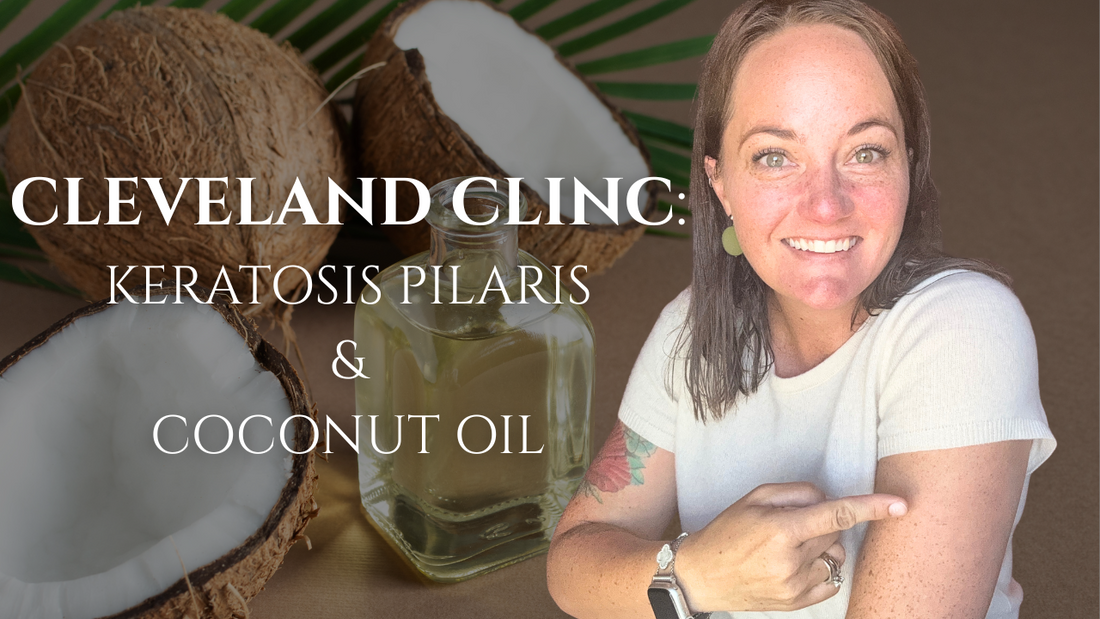And how it compares to my daily skincare routine for smoother, softer skin
If you’ve ever Googled “How do I get rid of keratosis pilaris?” or “What actually works for chicken skin?” you’re not alone.
Keratosis pilaris (KP) affects over 50% of adults—and for many women 40+, it gets worse with age, especially when skin becomes drier, thinner, and more sensitive.
In my latest YouTube video, I break down what the Cleveland Clinic says about treating KP with coconut oil. (Yes, it’s dermatologist-backed!) I also share real customer stories of how our Organic Coconut Oil Face & Body Polish has helped women smooth out rough, bumpy skin—many seeing a difference after just one use.
🎥 Watch the full video here:
What Cleveland Clinic Says About Coconut Oil for KP »
What Is Keratosis Pilaris (a.k.a. Chicken Skin)?
Keratosis pilaris is a harmless but frustrating skin condition that causes small, rough bumps—usually on the backs of arms, thighs, cheeks, or buttocks.
It’s caused by keratin buildup, which blocks the hair follicles and results in that sandpaper-like texture. For many women, it feels like their skin is never quite smooth, no matter how much they moisturize.
The Cleveland Clinic recommends gentle exfoliation, hydration, and consistent care to help reduce the appearance of KP over time.
How the Coconut Oil Polish Smooths KP Bumps
Our Organic Coconut Oil Face & Body Polish is a 5-in-1 multitasker designed to gently exfoliate and deeply moisturize at the same time—no extra steps or separate products needed.
Here’s how it helps with keratosis pilaris:
- Sugar gently exfoliates rough, bumpy skin without microtears or irritation
- Organic coconut oil softens and hydrates while supporting your skin barrier
- Daily use smooths texture and helps reduce the appearance of KP after just one week
- Fragrance-free and essential oil options make it safe for even the most sensitive skin
Women of all ages, but especially those 40+, have shared how this polish changed their skin. Many say their red bumps faded, rough patches smoothed out, and their skin looked visibly clearer and brighter. Some noticed a difference after just one use, but those who use it daily say their skin has never felt this soft and healthy.
“I’ve tried everything for my KP. This is the only thing that worked long-term—and it smells amazing.”
—Verified Customer Review
For the best results, use it daily in the shower and follow with our Mango Butter Crème while skin is still damp. This keeps moisture sealed in and helps prevent future dryness and flare-ups.
A Simple Routine That Works—Even for Sensitive Skin
This 2-step system—using the Polish in the shower and the Crème after—has helped thousands of women smooth out their skin and finally feel confident wearing sleeveless tops, shorts, or backless dresses again.
And because it’s made with food-grade ingredients and no harsh chemicals, it’s gentle enough to use on both face and body.
Try the Routine That Changed My Skin (and So Many Others)
Start your routine here:
Shop the Organic Coconut Oil Polish »
Add the Mango Butter Crème »
Or watch the full YouTube video to see what the Cleveland Clinic says about coconut oil for KP—and why consistent, natural care matters:
Chapters:
0:00 Cleveland Clinic on Coconut Oil for KP
0:19 Who Pure & Coco Helps
0:33 How Common is Keratosis Pilaris?
1:05 Who Gets KP Most Often
1:27 Skin Types Most Likely to Have KP
1:52 KP Considered a Skin Type
2:03 Keratosis Pilaris Symptoms
2:49 Is KP Caused by A Vitamin Deficiency?
3:05 How is KP Diagnosed
3:28 Location of KP
3:47 Characterists of KP
3:52 How to Treat Keratosis Pilaris
4:36 Exfoliating KP
4:54 Organic Coconut Oil Polish for KP
5:42 Gentle Skincare for KP
6:03 Cold-Pressed Coconut Oil Benefits
7:06 How Long Does it Take to Get Rid of KP
Cleveland Clinic credit: https://my.clevelandclinic.org/health/diseases/17758-keratosis-pilaris
